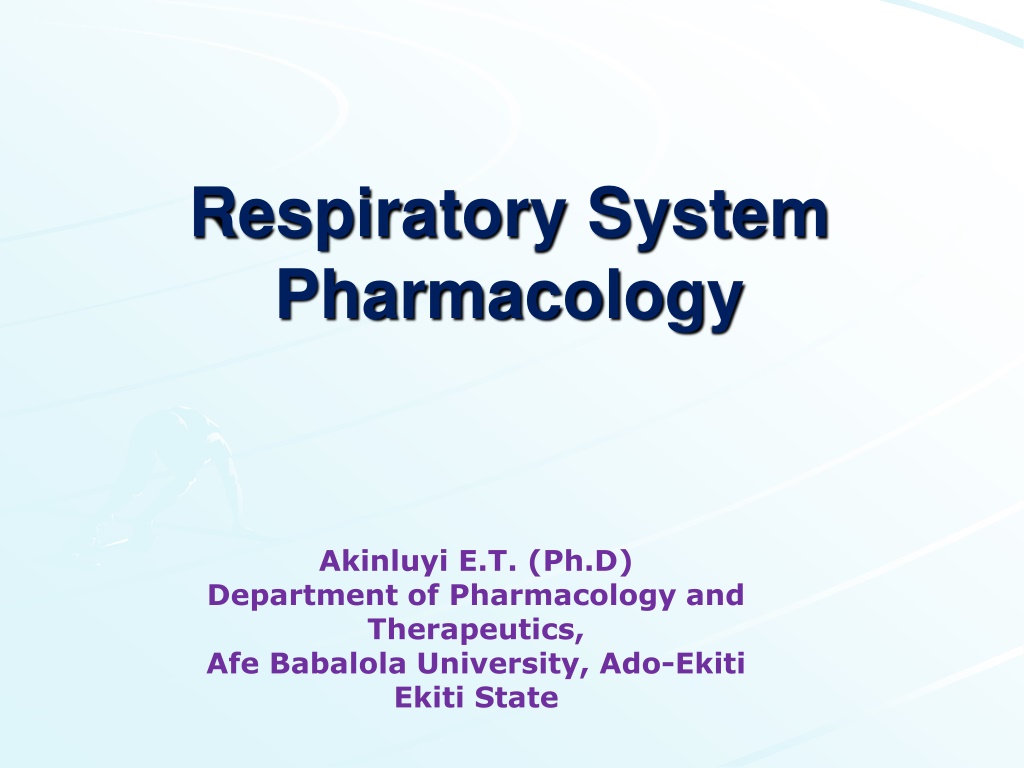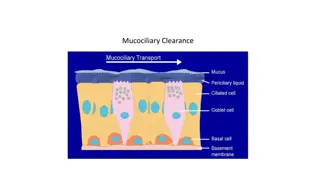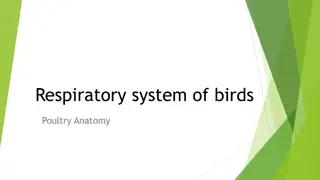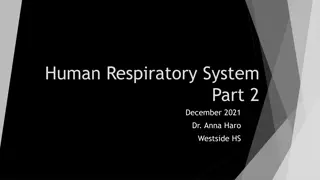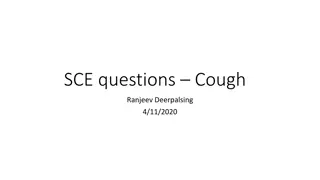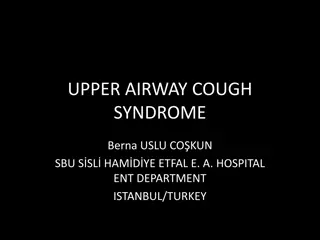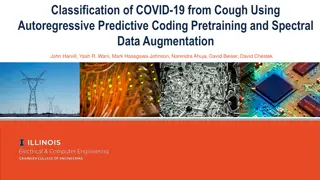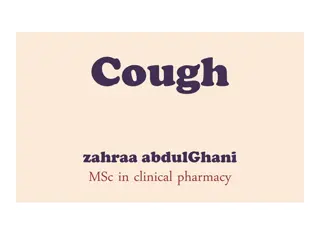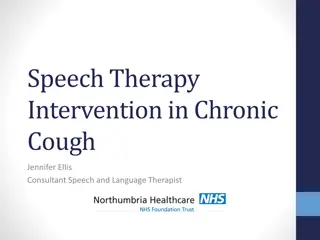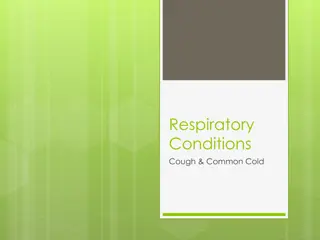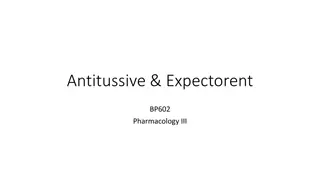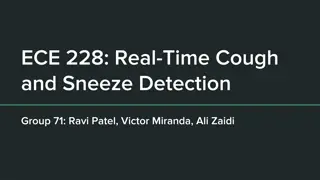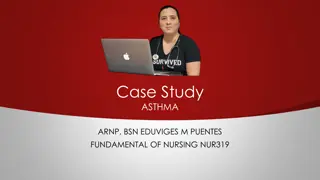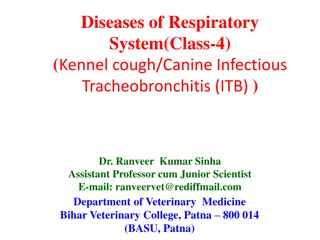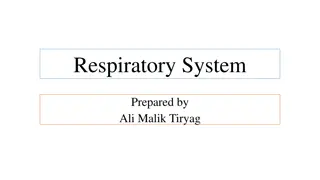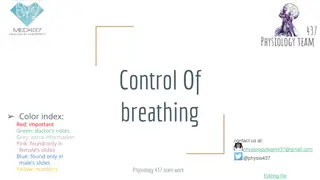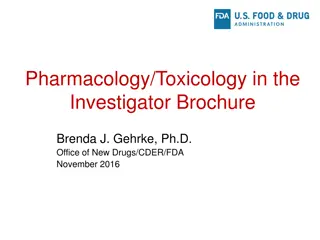Understanding Respiratory System Pharmacology and Cough Physiology
The regulation of respiration involves sensory and efferent pathways, with afferent pathways comprising stretch receptors, C-fibres, and irritant receptors, while efferent pathways include parasympathetic and sympathetic nerves. Cough physiology is a protective reflex initiated by various stimuli to clear the respiratory tract. The cough reflex involves sensory and efferent components, with stimuli triggering bronchoconstriction and mucus production. Understanding these processes is crucial in respiratory pharmacology.
Download Presentation

Please find below an Image/Link to download the presentation.
The content on the website is provided AS IS for your information and personal use only. It may not be sold, licensed, or shared on other websites without obtaining consent from the author. Download presentation by click this link. If you encounter any issues during the download, it is possible that the publisher has removed the file from their server.
E N D
Presentation Transcript
Respiratory System Pharmacology Akinluyi E.T. (Ph.D) Department of Pharmacology and Therapeutics, Afe Babalola University, Ado-Ekiti Ekiti State
The regulation of respiration Two pathways are involved in the regulation of respiration 1. Sensory receptors and afferent pathways 2. Efferent pathways. 1. The afferent pathways This comprises of the stretch receptors, the unmyelinated C- fibres and the irritant receptors associated with myelinated vagal fibres Irritant receptors on myelinated fibres and/or C-fibre receptors respond to exogenous chemicals, inflammatory mediators and physical stimuli, causing bronchoconstriction, mucus secretion and coughing.
2. Efferent pathways The efferent pathways comprises of: i. Parasympathetic nerves which causes bronchoconstriction and mucus secretion through M3 receptors. ii. Sympathetic nerves which innervates tracheobronchial blood vessels and glands only, and the adrenoceptors expressed on human airway smooth muscle (and mast cells, epithelium, glands and alveoli). agonists causes relaxation of bronchial smooth muscle, inhibition of mediators release from mast cells and increase in mucus clearance. iii. Non-adrenergic non-cholinergic (NANC) nerves: Inhibitory NANC nerves, relaxes smooth muscle by releasing nitric oxide and vasoactive intestinal peptide. Excitatory NANC nerves cause neuroinflammation by releasing substance P and neurokinin A.
Cough Physiology A Cough is a sudden and often repetitively occurring, protective reflex, which is initiated by infection, noxious fumes, dust, or other types of foreign bodies. The reflex results in a sudden expulsion of air to clear the respiratory tract of respiratory secretions or foreign particles. It is a physiologic mechanism or protective reflex (due to stimulation of mechano or chemoreceptors in the throat), and is one way in which the lungs and airways are protected from inhaled particles. Coughing sometimes brings up sputum (also called phlegm), a mixture of mucus, debris, and cells expelled from the lungs. Respiratory secretions and foreign objects are naturally removed by the cough reflex.
The cough reflex The cough reflex has both sensory (afferent) mainly via the vagus nerve and efferent components. Pulmonary irritant receptors in the epithelium of the respiratory tract are sensitive to both mechanical and chemical stimuli. Chemical or mechanical irritation of the epithelium within the bronchial mucosa causes bronchoconstriction, which in turn stimulates the stretch receptors tracheobronchial tree. located within the The internal laryngeal nerve carries the sensory information via the vagus nerve to the cough center located in the medulla oblongata. Stimulation of this area produces a cough to remove the foreign material from the respiratory tract before it reaches the lungs. Mucus production in the bronchi is an airway defense mechanism, and it increases with inflammation and infection.
Types of cough 1. Productive cough 2. Non productive cough 1) Productive cough: This type of cough is beneficial as it effectively drains the airway and expels excessive secretions and exudates. It helps remove harmful foreign substances from the airway. Its suppression is not desirable, may even be harmful. 2) Non productive cough: It is a dry cough. It is non- productive chronic cough and is due to smoking and local irritants. Apart from specific remedies (antibiotics), cough may be treated as a symptom
Symptomatic (nonspecific) cough therapies
Antitussives They are also called cough centre suppressants. These are agents that suppress the cough reflex on the medulla oblongata to suppress cough of many respiratory conditions. They are broadly classified into: 1) Central (CNS) acting: Opioids e.g. Codeine, Hydrocordone Non-opioids e.g. Benzonatate, Dextromethorphan 2) Peripherally acting: Prenoxdiazine
Opioids These agents suppress the cough reflex by direct action on the cough center in the medulla. Examples include Codeine, Hydrocordone, Ethylmorphine, Pholcodeine Codeine is an opium alkaloid, qualitatively similar to and less potent than morphine, but is more selective for cough centre. Codeine suppresses cough for about 6 hours. Adverse effects of codeine include: abuse liability; constipation; respiratory depression; drowsiness.
Non-opioids Examples: citrate, Noscapine, Chlophedianol Benzonatate, Dextromethorphan, Butamirate Dextromethorphan is a central NMDA (N-methyl D- aspartate) receptor antagonist. It works by inhibiting the cough center in the brain, elevating the threshold for coughing. It is a common ingredient of many antitussive combinations. Adverse effects of dextromethorphan include dizziness, nausea, drowsiness; at high doses hallucinations and ataxia may occur. Noscapine (Narcotine) exert its antitussive effects through the activation of sigma opioid receptors. It suppresses cough but has no narcotic, analgesic or dependence inducing properties. It is especially useful in spasmodic cough.
Peripherally acting antitussive Example is Prenoxdiazine It acts by desensitizing the pulmonary stretch receptors and reducing tussle impulses originating in the lungs. Does not cause respiratory depression. Does not cause addiction. Its efficacy is not impressive.
Expectorants They are also called mucokinetics. These are drugs that increase bronchial secretions or reduce its viscosity, facilitating its removal by coughing. Expectorants can be: a) Bronchial secretion enhancers: Drugs that are considered to increase bronchial secretion by salt action. E.g. Guaifenesin, sodium citrate, potassium citrate, potassium iodide, ammonium chloride, etc. b) Mucolytics: These are agents that breakdown mucous in order to help respiratory patients in coughing up thick, tenacious secretions. E.g. Bromhexine, acetylcysteine, carbocysteine, ambroxol, etc.
Mucolytics Mucolytic bromhexine is a potent mucolytic and mucokinetic, capable of inducing thin copious bronchial secretion. It depolymerizes mucopolysaccharides directly as well as by liberating lysosomal enzymes. This breaks the network of fibers in tenacious sputum. Side effects include rhinorrhoea and lacrimation, nausea, gastric irritation, hypersensitivity. Ambroxol is a metabolite of bromhexine having similar mucolytic action, uses and side effect. Acetylcysteine acts by opening the disulfide bonds in mucoproteins present in sputum, making it less viscous. It has to be administered directly into the respiratory tract. Carbocisteine liquefies viscous sputum in the same way as acetylcysteine. It is administered orally. It may break gastric mucosal barrier, and so is contraindicated in peptic ulcer patients. Side effects include gastric discomfort and rashes
Pharyngeal demulcents Pharyngeal demulcents soothe the throat and reduce afferent impulses from the inflamed/irritated pharyngeal mucosa, thus provide symptomatic relief in dry cough arising from throat. Examples include Lozenges, cough drops, linctuses glycerine and liquorice.
Bronchodilators Bronchospasm can induce/aggravate cough, especially in individuals with bronchial hyper-reactivity. Bronchodilators relieve cough in such individuals They improve the effectiveness of cough in clearing secretions by increasing the surface velocity of airflow during cough Examples include Salbutamol and Terbutaline
Antihistamines This class of drugs are used to block the release or action of histamine- a chemical mediator of inflammation that increases secretions and constricts the air passageway They directly compete with histamine for specific receptor sites. There are two histamine receptors: histamine-1 (H1) and histamine-2 (H2) The H2 Blockers are used to reduce gastric acid in peptic ulcer disease, while the H1 blockers are agents designed to relieve respiratory symptoms and to treat allergic conditions. The antihistamines selectively block the effects of histamine at the H1 receptor sites in the target tissue by competing with histamine for the receptor, decreasing the cellular responses. They are more effective in preventing the actions of histamine rather than reversing them. They also have anticholinergic properties.
Histamine vs. Antihistamine Effects 1. Smooth Muscle (on exocrine glands) Histamine effects: Stimulate salivary, gastric, lacrimal, and bronchial secretions Antihistamine effects: Prevent salivary, gastric, lacrimal, and bronchial secretions 2. Immune System (Release of substances commonly associated with allergic reactions) Histamine effects: Mast cells release histamine and other substances, resulting in allergic reactions. Antihistamine effect: Binds to histamine receptors, thus preventing histamine from causing a response.
3. Anticholinergic: Drying effect that reduces nasal, salivary, and lacrimal gland secretions (runny nose, tearing, and itching eyes) 4. Sedative: Some antihistamines cause drowsiness Most common side effects of antihistamines are the anticholinergic (drying) effects. These include: Dry mouth Difficulty urinating Constipation Changes in vision Antihistamines also cause drowsiness (Mild drowsiness to deep sleep)
Bronchial asthma Asthma is characterized by hyper-responsiveness of the trachea and bronchi smooth muscles to various stimuli resulting in: i. ii. iii. iv. Contraction or airway smooth muscles Increased secretion Mucosal edema Mucus plugging. Of these causes of airway obstruction, contraction of smooth muscle is most easily reversed by current therapy. Reversal of edema and cellular infiltration requires sustained treatment with anti-inflammatory agents Symptoms of asthma include: i. ii. iii. iv. Dyspnea Wheezing Cough Chest tightness
Pathogenesis of Asthma Asthma maybe categorized into two: Allergic or atopic asthma Non-allergic or non-atopic asthma 1. ALLERGIC ASTHMA There is evidence of allergen sensitization It usually begins in childhood and is triggered by environmental allergens such as dust mites, pollens, cockroaches, molds, animal dander or foods. Positive family history and positive skin test resulting from the offending antigen. There is hay fever Elevated antibodies immunoglobulin E (IgE)
2. Non-allergic asthma No evidence of allergen sensitization There is negative skin test result No positive family history Normal serum IgE Occurs in middle aged subjects Common triggers are viruses (rhinovirus, parainfluenza virus) which causes respiratory infections. Inhaled air, pollutants such as sulfurdioxide, ozone and nitrogen dioxide may also contribute to chronic inflammation In these patients, there is hyperirritability of the bronchial tree
Immediate phase of asthma attack In allergic asthma, the immediate phase (i.e. the initial response to allergen provocation) occurs abruptly and is mainly caused by spasm of the bronchial smooth muscle. Allergen interaction with mast cell-fixed IgE causes release of histamine, leukotriene B4 and prostaglandin (PG) D2. Other mediators released include IL-4, IL-5, IL-13, macrophage inflammatory protein-1 and tumour necrosis factor (TNF)- . Various chemotaxins and chemokines attract leucocytes- particularly eosinophils and mononuclear cells-into the area, setting the stage for the delayed phase
The late phase The late phase involves a progression of the inflammatory reaction which was initiated in the early phase. The most important of these is the influx of Th2 lymphocytes Synthesis and release of a variety of cytokines: interleukins 3 and 5, granulocyte-macrophage colony-stimulating factor (GM- CSF), and tissue growth factor (TGF) from T cells and mast cells. These cytokines in turn attract and activate eosinophils and neutrophils, whose products include eosinophil cationic protein (ECP), major basic protein (MBP), proteases, and platelet- activating factor. These mediators cause the edema, mucus hypersecretion, smooth muscle contraction, and increase in bronchial reactivity associated with the late asthmatic response.
BASIS FOR PHARMACOTHERAPY 1.) To reverse bronchoconstriction: Bronchodilators -Adrenoceptor agonists Anticholinergics Xanthine derivatives 2.) To control or prevent inflammation: Corticosteroids Leukotriene antagonists Mast cell stabilizers Anti-IgE antibody
-Adrenergic receptor agonists Activation of 2-receptors located on the bronchiolar smooth muscle stimulates adenylyl cyclase and increase in cyclic adenosine monophosphate (cAMP) to cause bronchodilation 2-receptor agonists dilate the bronchi by a direct action on the 2-receptors of smooth muscles. They cause rapid dilation of the airways They also inhibit the mediators of bronchoconstriction They inhibit mediator release from mast cells and TNF- release from monocytes. They also increase mucus clearance by an action on the cilia. They are the first-line drugs for the acute treatment of asthma attacks, but can also be used for the chronic treatment. They are usually given by inhalation Prolonged use may lead to desensitization and receptor downregulation
Categories of 2-Adrenergic receptor agonists 1. Non-selective -adrenergic agonists: Epinephrine 2. 2- selective adrenergic agonists i) Short acting agents: Albuterol (Salbutamol), terbutaline, bambuterol. These agents are usually used for the treatment of acute asthma attacks. They have rapid onset of action, causes quick relief. They are given by inhalation; the maximum effects occurs within 30 min and the duration of action is 3-5 h. They can be combined with ipratropium bromide
ii)Long acting agents: Salmeterol and formoterol. They are used for the prevention of asthma attacks and for chronic management of asthma. They have a long duration of action (between 8-12 h), but slower onset of action. Therefore, they are not to be used for the quick relief of an acute asthma attack. These agents are only given by inhalation These drugs appear to interact with inhaled corticosteroids to improve asthma control. They are given regularly (2x daily) as an adjunctive therapy in patients whose asthma is inadequately controlled by corticosteroids. They are not recommended for the sole therapy for asthma Salmeterol has 10-12 h of bronchodilator effect. It is generally combined with a corticosteroid (fluticasone propionate) Formoterol s bronchodilator effect last for about 12 hours. It can be combined with the corticosteroids budesonide or beclomethasone dipropionate.
Unwanted effects of -adrenergic agonists In the context of asthma, the commonest adverse effect is tremor. Other unwanted effects include: Tachycardia Cardiac dysrhythmia.
Anticholinergics Examples: Ipratropium bromide and tiotropium They block the muscarinic type-cholinergic receptors on bronchiolar smooth muscles and mast cells, leading to bronchodilation. Ipratropium blocks bronchoconstriction mainly in the larger airways while 2 agonists mainly relaxes bronchiolar smooth muscles, but they do not have any superiority to 2 agonists. It can be used alone or combined with 2 agonists Ipratropium bromide- short acting (4 6 hours) Tiotropium bromide- long acting (24 hours). They are the bronchodilators of choice in COPD. They are not recommended in acute asthma.
Methylxanthines Examples include Theophylline, theobromine, caffeine. They act as competitive inhibitors of phosphodiesterase enzyme (PDE; the enzyme that hydrolyses cyclic nucleotides), leading to increased intracellular cAMP and cGMP levels. The levels of cAMP determine the degree of bronchodilation, and when the levels are increased, there is an increased relaxation of smooth muscle. These agents have also been proposed to inhibit the action of adenosine at its receptor (A1 and A2) sites. When adenosine binds to its receptors, it provokes contraction of isolated airway smooth muscle and histamine release from airway mast cells.
Indications for use used as a bronchodilator for the treatment of asthma although its not a first line drug due to its varying side effects. used more for chronic obstructive pulmonary disorder (COPD) Adverse reactions Nausea and vomiting-most often seen adverse effect. Agitation, insomnia and convulsions-CNS stimulant effect Cardiac arrhythmia- cardiac stimulant Gastric disorders- increase (contraindicated in peptic ulcer) gastric acid secretion Note: theophylline has a very narrow therapeutic window, and so plasma levels are closely monitored
INHIBITORS OF INFLAMMATION
Corticosteroids Corticosteroids suppress the mucosal inflammation (anti- inflammatory effect) and decrease the mucosal edema. They have no bronchodilator effects. They are used for the prophylaxis of asthma attacks. They have anti-inflammatory actions by inhibiting cytokine synthesis, reducing prostaglandins, thromboxane A2 levels. They permeability leukotrienes, decrease and also vascular They increase the susceptibility of -adrenergic receptors to endogenous ligands. They also play a role in preventing the development of tolerance to -agonist drugs They have late onset of action (3 7 days) There are 2 categories: inhaled and systemic corticosteroids
i) Inhaled corticosteroids Examples: bedomethasone dipropionate, budesonide, fluticasone propionate They are not used alone for acute asthma attacks but in combination with salmeterol or salbutamol. They have high topical and low systemic activity (due to poor absorption/ or marked first pass metabolism). Thus, systemic adverse effects are rarely seen compared to parenteral and oral forms They can be used in patients who have been started with oral steroids or who have no history at all. Adverse effects include: dysphonia, cough, oral candidiasis, adrenal cortex suppression and atrophy (caused by long-term use of high doses), risk of osteoporosis and retardation of vertical bone growth
ii) Systemic steroids (oral and parenteral forms) Examples: i.v. hydrocortisone, oral prednisolone and methylprednisolone. Systemic steroid therapy is resorted to in asthma in the following situations: a) Severe attacks that is not controlled by bronchodilators and inhaled steroids or when there are frequent recurrences of increasing severity. b) Patients with status asthmaticus or acute asthma exacerbation: This is asthma attack not responding to intensive bronchodilator therapy.
Leukotriene antagonists Examples include Zafirlukast and montelukast They act as competitive antagonists of leukotriene receptors. These drugs bind to Cys-LT1 receptor; expressed in the respiratory mucosa and infiltrating inflammatory cells. Stimulation of this receptor by leukotrienes results in bronchoconstriction Zafirlukast and montelukast competitively inhibit the effects of leukotrienes on their receptor, thereby inhibiting bronchial smooth muscle contraction. They recruitment of eosinophils, basophils. They inhibit the increase in mucus production. also inhibit increased vascular permeability and Zileuton is a potent selective inhibitor of 5-lipoxygenase activity, therefore it inhibits the formation of all the products of 5- lipoxygenase; this now result in the inhibition of the formation of the leukotrienes.
Mast cell stabilizers Examples are: Cromolyn sodium, nedocromil sodium These drugs inhibit mast cell degranulation via stabilizing the mast cell membrane. However, they do not have bronchodilator action and do not antagonize constrictor action of histamine They are used to prevent an asthma attack, but is not useful during the attack, when the mediators have already been released. They are used for the chronic management of asthma (prophylaxis) only via inhalation. They are not used for severe asthma attacks. Cromolyn sodium possess low efficacy in asthma prophylaxis, but also low toxicity and adverse effect profile. It is generally used as an adjuvant drug to agonists and inhaled corticosteroids in asthma prophylaxis. It is used in exercise-induced asthma, allergic rhinitis and allergic conjuctivitis Nedocromil is more effective in the elderly and used locally also in allergic rhinitis and allergic conjuctivitis.
Anti-IgE Antibody Example is Omalizumab It is a humanized monoclonal antibodyagainst IgE (anti-IgE Mab). It inhibits the binding if IgE to mast cells but does notactivate IgE already bound to these cells and thus does not provoke mast cell degranulation. It is administered s.c. and used in adults and adolescents older than 12 years of age with allergies and moderate to severe persistent asthma. In severe extrinsic asthma, omalizumab has been found to reduce exacerbations and is proven to be effective in reducing the dependency on inhaled and oral corticosteroids. Adverse effects include increase in serum hepatic enzymes, headache and dyspepsia Drug interactions may be dangerous especially with theophylline and warfarin.
Chronic obstructive pulmonary disease (COPD) COPD is also an inflammatory disease of the lungs characterized by: 1. Obstruction and/or destruction of alveoli 2. Bronchiolar fibrosis / chronic bronchitis 3. Loss of bronchiolar elasticity leading to closure of smaller air tubes during expiration. Major cause of COPD is cigarette smoking. Air pollution is also aetiologically important The airway obstruction is accentuated during exercise causing shortness of breath. Bronchodilators prevent closure of peripheral air tubes during expiration and afford symptomatic relief in COPD patients, but improvement is generally <15%. An increasing part of airway obstruction is irreversible.
Pharmacotherapy of COPD Inhaled bronchodilators 1. Anticholinergic agents : ipratropium, tiotropium 2. 2-adrenergic agonists 3. Anticholinergic agents + 2-adrenergic agonists: Albuteron + ipratropium, salmeterol + tiotropium Inhaled corticosteroids Roflumilast : Roflumilast is a phosphodiesterase type 4 (PDE4) inhibitor. It elevates cAMP levels in inflammatory cells, causing inhibition of inflammatory mediator release.
